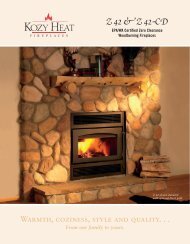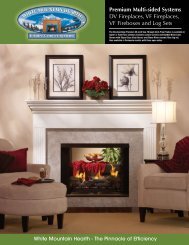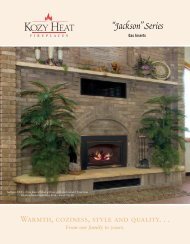GAS GRILL - Ashwood Hearth & Home Energy & Fireplace
GAS GRILL - Ashwood Hearth & Home Energy & Fireplace
GAS GRILL - Ashwood Hearth & Home Energy & Fireplace
You also want an ePaper? Increase the reach of your titles
YUMPU automatically turns print PDFs into web optimized ePapers that Google loves.
14GENERAL INSTRUCTIONSSlide out Bottom tray - Remove excess grease, then wash with warm soapy water,then rinse.Flavorizer ® bars and Cooking grates - Clean with a suitable brass bristle brush. Asneeded, remove from grill and wash with warm soapy water, then rinse with water.Catch pan - Disposable foil trays are available, or you can line the catch pan withaluminum foil. To clean the catch pan, wash with warm soapy water, then rinse.Thermometer - Wipe with warm soapy water; clean with plastic scrub ball.Inside cooking module - Brush any debris off of burner tubes. DO NOT ENLARGEBURNER PORTS (OPENINGS). Wash inside of cooking box with warm soapy waterand a water rinse.Inside Lid - While lid is warm, wipe inside with paper towel to prevent grease build-up.Flaking built-up grease resembles paint fl akes.Stainless steel surfaces - Wash with a soft cloth and a soap and water solution. Becareful to scrub with the grain direction of the stainless steel.Do not use cleaners that contain acid, mineral spirits or xylene. Rinse well aftercleaning.Preserve Your Stainless SteelYour grill or its cabinet, lid, control panel and shelves may be made from stainless steel.To keep the stainless steel looking its best is a simple matter. Clean it with soap andwater, rinse with clear water and wipe dry. For stubborn particles, the use of a nonmetallicbrush can be used. IMPORTANT: Do not use a wire brush or abrasive cleanerson the stainless steel surfaces of your grill as this will causescratches. IMPORTANT: When cleaning surfaces be sure to rub/wipe inthe direction of the grain to preserve the look of your stainlesssteel.<strong>GAS</strong> INSTRUCTIONSINSTALL <strong>GAS</strong> SUPPLYGeneral Specifications for PipingNote: Contact your local municipality for building codes regulating outdoor gasbarbecue installations. In absence of Local Codes, you must conform to thelatest edition of the National Fuel Gas Code: ANSI Z 223.1/NFPA 54, or CAN/CGA-B149.1, Natural Gas and Propane Installation Code. WE RECOMMEND THAT THISINSTALLATION BE DONE BY A PROFESSIONAL.Some of the following are general requirements taken from the latest edition of theNational Fuel Gas Code: ANSI Z 223.1/NFPA 54, or CAN/CGA-B149.1, Natural Gas andPropane Installation Code for complete specifi cations.• This barbecue is designed to operate at 4.5 inches of water column pressure (.163psi).• A manual shut-off valve must be installed outdoors, immediately ahead of the quickdisconnect.• An additional manual shut-off valve indoors should be installed in the branch fuelline in an accessible location near the supply line.• The quick disconnect connects to a 1/2 inch NPT thread from the gas source. Thequick disconnect fi tting is a hand-operated device that automatically shuts off thefl ow of gas from the source when the barbecue is disconnected.• The quick disconnect fi tting can be installed horizontally, or pointing downward.Installing the fi tting with the open end pointing upward can result in collecting waterand debris.• The dust covers (supplied plastic plugs) help keep the open ends of the quickdisconnect fi tting clean while disconnected.• Pipe compound should be used which is resistant to the action of natural gas whenconnections are made.• The outdoor connector must be fi rmly attached to rigid, permanent construction. WARNING: Do not route the 10 foot hose under a deck. Thehose must be visible.Gas Line Piping• If the length of the line required does not exceed 50 feet, use a 5/8" O.D. tube. Onesize larger should be used for lengths greater than 50 feet.• Gas piping may be copper tubing, type K or L; polyethylene plastic tube, with aminimum wall thickness of .062 inch; or standard weight (schedule 40) steel orwrought iron pipe.• Copper tubing must be tin-lined if the gas contains more than 0.3 grams ofhydrogen sulfi de per 100 cubic feet of gas.• Plastic tubing is suitable only for outdoor, underground use.• Gas piping in contact with earth, or any other material which may corrode thepiping, must be protected against corrosion in an approved manner.• Underground piping must have a minimum of 18" cover. DANGERDo not use an open flame to check for gas leaks. Be surethere are no sparks or open flames in the area while youcheck for gas leaks. This will result in a fire or explosionwhich can cause serious bodily injury or death and damageto property.Inside wallOutside wallThis is a typical installationof a Weber ® natural gasbarbecue. Local codes mayrequire differentinstallations.QuickdisconnectDo Not Use1 /2 " PipenippleGas supplyShut offLocking shut offTest ConnectionsAll connections and joints must be thoroughly tested for leaks in accordance with localcodes and all listed procedures in the latest edition of the National Fuel Gas Code: ANSIZ 223.1/NFPA 54, or CAN/CGA-B149.1WWW.WEBER.COM ®







